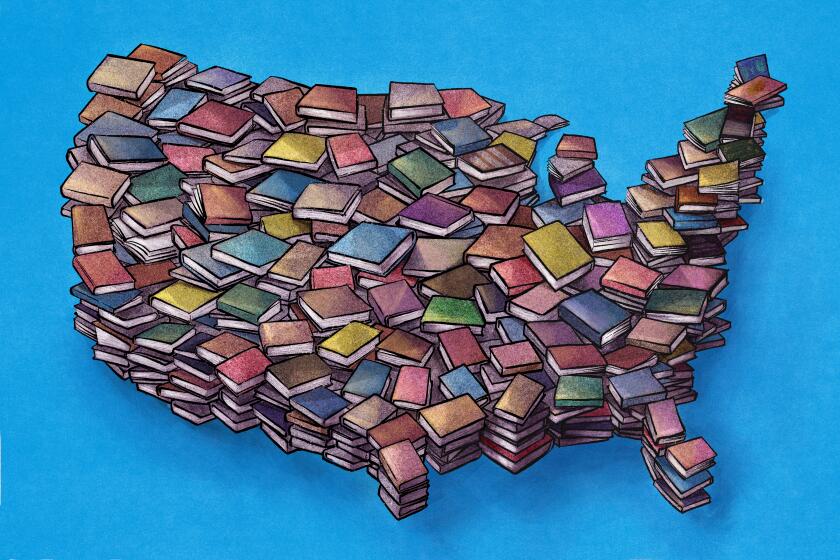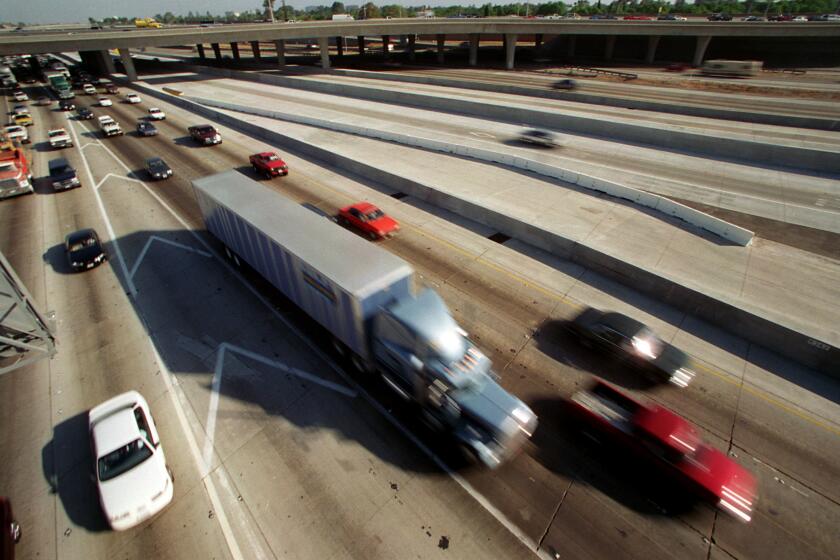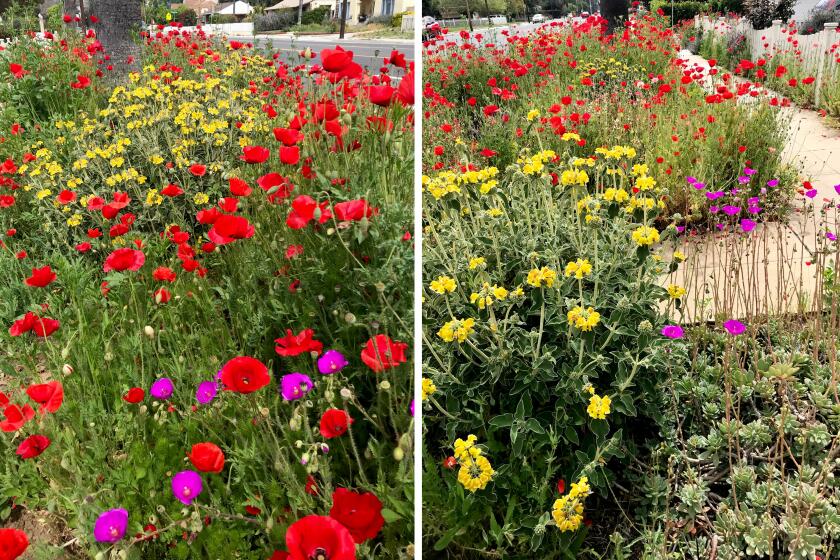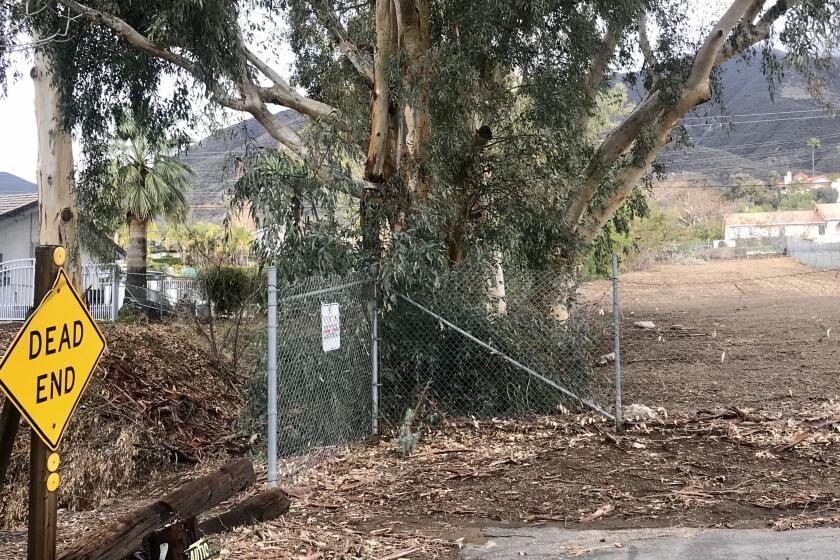Opinion: Can you beat this epic commute? Take the 10 to the 86 to the 111 to the 8 ...
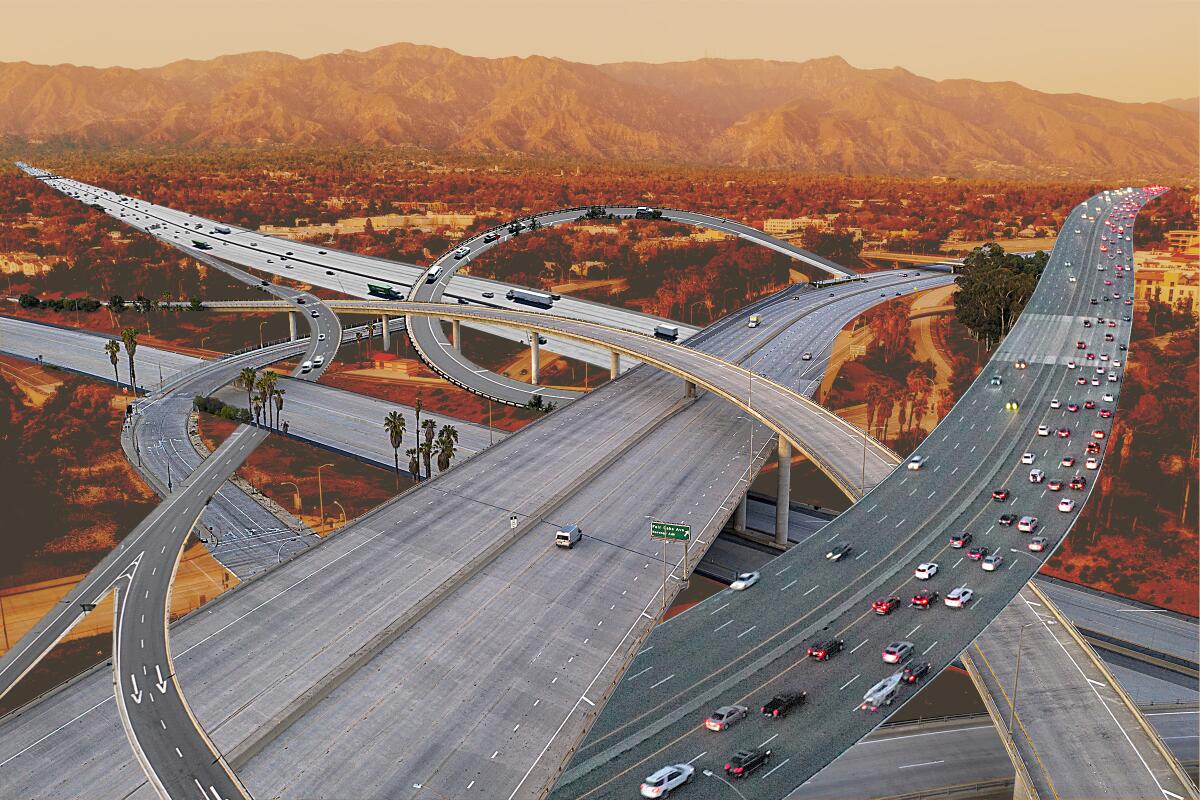
During the fierce February rainstorms, I had to drive from Riverside to Santa Barbara and back. Flooding was everywhere, and on my way home, I took an alternate route. I started off on the 101, then turned onto Highway 126 through the beauty of Santa Paula and Fillmore, the clouds massive and purple, to the 5 in Castaic, then onto the 14 along the edge of the Angeles National Forest. Finally I turned east on 138, the Pearblossom Highway. The roadway was full of commuters, but as we skirted Mt. San Antonio, covered with snow, and the late-afternoon sun came shining through cholla cacti and Joshua trees, I thought, where else could I see this — snowfall and golden desert?
Of course, it took forever to get home to Riverside. On the 215, I dropped down the Cajon Pass, which always reminds me that thousands of pioneers navigated that steep grade with wagon wheels. The 215 teems with drivers and memories of all the stories told by my parents, my in-laws and the countless others who arrived in Southern California along old Route 66.
Finally, more than three hours later, I merged onto the 91 and made it home. Standing at the curb talking to my next-door neighbor Mario, I told him where I’d been, how long it had taken. He just grinned, a victory gleam in his eye.
Over five years, I read 1,001 novels to hear the voices that fill this country. These books showed me that the places of American fiction can’t be divided into blue or red states.
Mario drives a truck loaded with equipment, topped with a crane, installing massive new heating and A/C units for cellphone towers. Last year, he worked at 238 sites. This year, his schedule calls for nearly 500.
When we compare driving stories, he always wins. He said, “You only went to Santa Barbara? Yesterday I went to Oxnard. Then I went to Phoenix.”
He took the 60 to the 101 to Oxnard, then back on the 10. “For six hours.”
Sometimes Mario gets home at 2 a.m., corridos unfurling from his open driver-side window, and leaves again at 6. He and his wife, Nancy, have three sons and two daughters; his mother-in-law lives with them, and so do six dogs and 10 birds.
Freeway shootings in Southern California revive memories of my fears of a man dubbed the “Phantom Rock Thrower,” who haunted the 91 Freeway in 1977.
In my neighborhood, where so many drive a hard commute, after you get out of your vehicle, stretch on the sidewalk, pull a few weeds near the fence, walk your dog, play with your kids and start the grill, you joke about driving. I am the fortunate one here — for 35 years, my daily drive has been just eight miles to UC Riverside and back. I wouldn’t have had it any other way. If an earthquake came, I could actually run to my kids.
But a lot of Californians put in long hours on the freeways. Here in inland SoCal, where housing is less expensive than it is closer to the coast, epic commutes are just what you do, so you can own a house and because you’re probably an essential worker. My neighbors are all essential.
When I take the dogs out in late afternoon, I see Jose from down the street, in his uniform from Sysco, the national warehouse chain, walking his two white poodles. He’ll fit in a nap and then head for his second job, the night shift at Petco.
At about the same time, my neighbor Brian will be getting out of his County of San Bernardino truck. He’s a maintenance supervisor. Remember, San Bernardino County is larger than seven states, as well as Belgium and Switzerland. Brian used to have one word for me after work in the summertime: “Needles.” He was taking the 215 up to the 40 and turning east, 225 miles one way. Lately he’s been working in Rancho Cucamonga — only 18 miles away.
A California garden grows in a parking strip, where poppies nod into the bike lane, brushed back by roaring Harleys and pickups.
“Saturday Night Live’s” long-running skit series “The Californians” featured Fred Armisen, Kristen Wiig and others chanting routes to laughs. I used to hate how easy it was for the New York show to parody California. But watching it again, I see Devin — Bill Hader in a sleeveless flannel shirt and waffle-knit undershirt — as a SoCal contractor working his ass off while, yes, “breaking hearts in Rancho Cucamonga and San Bernardino.” When guest star Bradley Cooper, playing a pool cleaner, spins a tale about being a juvenile delinquent, I love his litany of freeways — from the 5 to the 73 to the 405 to Fountain Valley — especially the specificity of the 73.
We live in a big state and we think nothing of driving it, end to end. From Riverside, I’ve driven to readings at the high school in Campo, in the mountains a few miles from the southern border; to libraries in Mecca and La Quinta, Newport Beach and Milpitas; to an elementary school multipurpose room in rural Greenfield, the lettuce capital of the nation; and to colleges and bookstores up and down the state. When my last novel came out, I drove to San Francisco for an event near Golden Gate Park; then, at 10 p.m., I started back south to Moorpark College for a morning event. I picked up the 101 mid-city, connected to the 80, then the 580, headed down the 5, and by 2 a.m., I was on the 118, heading west over Santa Susana Pass.
Writer Susan Straight traverses a California different than the one Joan Didion observed yet views it through eyes partly focused by her Didion’s writing.
Finally home the next night, I thought I’d win the neighborhood contest. But of course, Mario said: “That ain’t nothing. I went to Calexico, and then to Rancho Bernardo on the way back.” In one day. He made his way to the 10 and then took the 86 to the 111, back up to the 8, then to the 15 and the 215.
A few years ago, for our middle daughter, Delphine, my ex-husband and I rented a new pickup truck and drove her things from Riverside to Albany, where she and her husband had moved into UC Berkeley married-student housing.
“We took the 215 up to the 210 to the 5, and then I had to tell your mom to get me ready for all them 80s,” he told Delphine. “I hate the 80s up here, where y’all are.”
He meant that we took the 5, which he loves for the stories we tell on the way, so many stories we never turn on the radio for five hours. He loves the gas stations with pistachios, the memories of his college basketball days playing games in Monterey and Stanislaus counties, all the gyms and courts. Then we get to Tracy, when we turn left and he loses his mind. I used to get out an old Auto Club map, but now I use the phone to navigate the freeways that make him so nervous: the 280, 580, 680 and 880, to name a few.
Only two weeks later, we rented another new pickup truck and took the 60 to the 101, to East Hollywood, where our youngest daughter, Rosette, lived, to move her belongings to an apartment in South Pasadena. That was the 101 to the 110, twice, to unload her things. Then home at rush hour: Colorado Boulevard (historic Route 66 again) to the 210 to the 57 to the 10 to the 15 to the 60. Two hours. Thank goodness we had chicken and waffles at Roscoe’s in Pasadena before we headed back.
Susan Straight is a contributing writer to Opinion. In “Mecca,” her most recent novel, the characters travel freeways in five Southern California counties.
More to Read
A cure for the common opinion
Get thought-provoking perspectives with our weekly newsletter.
You may occasionally receive promotional content from the Los Angeles Times.
